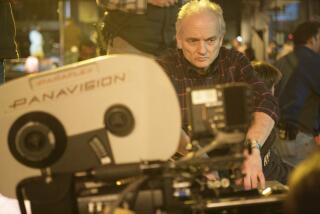Review: Sam Wasson takes a deep dive into ‘Chinatown’
The making of the great 1970s classic in all its glory and darkness
“Chinatown” may or may not be the greatest movie of the so-called New Hollywood (I think not) but it is one of the best, and its cynical vibe — perhaps “realistic” would be a better word — makes it as much a movie for our time as it was for its own, 1974. Among other things, it is a testimonial to Balzac’s famous aphorism, “Behind every great fortune lies a great crime.” The great crime behind “Chinatown” is the theft of water from the farmers of the Owens Valley that gave Noah Cross, the film’s villainous developer, his great fortune and Angelenos their drinking water. Cross is “Chinatown’s” Donald Trump.
Sam Wasson’s fascinating and page-turning description of the talent and ideas behind “Chinatown” is more than a mere biography of a landmark movie; it aims to flesh out the wild and woolly era that incubated it, roughly the late 1960s to the late 1970s, and in this it mostly succeeds. “Chinatown’s” relative greatness is irrelevant for Wasson’s purposes, thanks to its spectacular backstory, featuring four of the most gifted and colorful figures of the era: Jack Nicholson, Roman Polanski, Robert Towne and Robert Evans. Of the Big Four, only Polanski and Evans — who was such a press whore he would talk to a tree if addressed — agreed to participate. But they are abetted by a stellar cast of players, including Nicholson’s sometime girlfriend Anjelica Huston, whose father, John, plays Cross; assistant director Hawk Koch; and costume designer Anthea Sylbert — all of whom are happy to connect the dots. Faye Dunaway, who played Cross’ daughter, Evelyn Mulwray, didn’t cooperate.
The picture that emerges is not unfamiliar in its elements: the murder of Sharon Tate; Evans’ resuscitation of Paramount; the ferocious battles between Polanski and, variously, Towne for refusing to shrink his script, Dunaway for being a diva and Nicholson for preferring the Lakers to the movie in which he was starring; Polanski’s conviction for “unlawful sexual intercourse”; and finally, Towne, Evans and Nicholson in a battle royal over the fiasco called “The Two Jakes.”
Despite the well-trod terrain, Wasson has flushed so many fresh sources out of the woodwork, and dived so deeply into the voluminous existing interview material, that we barely notice the absence of Towne and Nicholson. Wasson proves himself an indefatigable researcher, plundering every imaginable scrap of relevant material from court records (Polanski’s polygraph from the Tate-LaBianca investigation) to transcripts from “The Dick Cavett Show” and the musings of Roland Barthes.
Of particular interest is the new material Wasson has uncovered concerning the contribution of Edward Taylor to the development of the script. When Towne was a nobody, his career got a bump from his pal Warren Beatty, who hired him to fiddle with the screenplay for “Bonnie and Clyde” and credited him, cryptically, as a “special consultant.” Subsequently, Towne became known not only as a writer of brilliant original scripts like “The Last Detail” and “Shampoo” but also as a script doctor, a shadow writer, often uncredited.
Taylor was Towne’s script doctor, the shadow’s shadow as it were. According to Wasson, Towne paid Taylor, his oldest friend and former college roommate, to work on almost all his scripts but kept his role under wraps, acknowledging him only once, in an essay published by The Times. Taylor, for his part, appeared satisfied to remain the man behind the curtain, neither asking for nor expecting credit.
Wasson’s intensive research has allowed him to create a tapestry so dense with detail that the characters spring to life on the page. Occasionally, however, he forgets the meaning of “enough,” conflating information with trivia and drowning us in more facts than we could possibly want. Thus, we not only read about Hira, Towne’s famously hirsute, jumbo-sized, Hungarian Komondor, acquired as a guard dog in the wake of the Manson murders, but also Scylla, the Komondor that preceded him but was deemed insufficiently fierce.
If this book has a flaw, it is Wasson’s intoxication with his subjects. Evans, for example, emerges as a heroic figure, but where is his coke-addled dark side? Where is the producer whom Francis Coppola hated and banned from the set of “The Cotton Club”? Evans had an ego the size of Woodland, his legendary home in Beverly Hills, and, to put it tactfully, not everything he said can be taken at face value.
Nevertheless, in “Chinatown,” Wasson has found the perfect vehicle for convincingly demonstrating how personal filmmaking in a commercial context, albeit fueled by drugs and worse, enabled the New Hollywood to break the studio mold and reinvent the art of the feature film. It’s unfortunate but true that “Chinatown” wouldn’t exist in its present form had Evans not been consumed with the ambition to be taken seriously as a filmmaker, or at the very least a producer; had Towne not been haunted by his complicated relationship to his overbearing father, a developer like Cross; and had Tate not been murdered.
Towne, raised in Los Angeles in the lap of luxury, wanted a happy ending for his movie, in which daughter Evelyn kills Cross, punishing him for violating her (and fathering his daughter’s daughter). Polanski, however, raised in the Warsaw Ghetto under the boot of the Nazis, had seen too much to believe in happily-ever-after. As Polanski and Towne once told me, the director objected: “I thought it was a serious movie, not an adventure story for kids.” Towne understood. “Beautiful blondes die in Los Angeles,” he explained. “Sharon had.” And so does Evelyn, while Cross survives.
The convoluted plot finally takes the characters to Chinatown, where Evelyn, behind the wheel of a white convertible in the stunning penultimate scene, is shot by the cops and halfway falls out of her seat, her blond hair dragging in the gutter while Nicholson’s detective, Jake Gittes, stands by helplessly as his partner speaks the line for which the movie is famous: “Forget it Jake, it’s Chinatown.”
Biskind is the author of many books, including “Easy Riders, Raging Bulls: How the Sex-Drugs-and-Rock ’n’ Roll Generation Saved Hollywood.”
The Big Goodbye: Chinatown and the Last Years of Hollywood
Sam Wasson
Flatiron: 416 pages; $29
More to Read
Sign up for our Book Club newsletter
Get the latest news, events and more from the Los Angeles Times Book Club, and help us get L.A. reading and talking.
You may occasionally receive promotional content from the Los Angeles Times.








